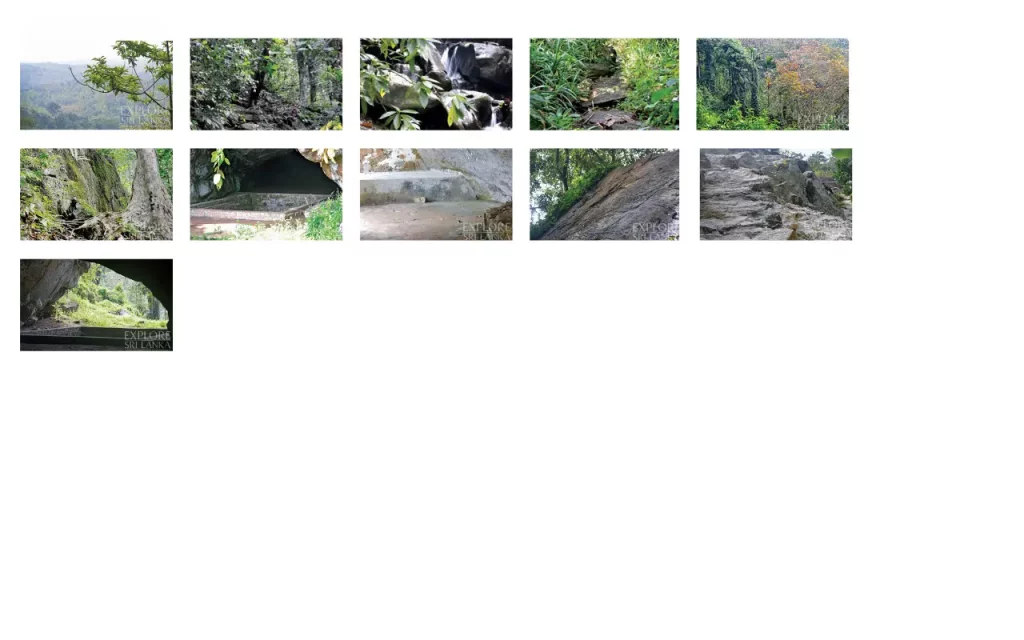
A little piece of an Amazonian jungle lies hidden and generally unknown not even a two hour drive away from the heart of the nation’s capital, Colombo. High on a mountain belonging to the Samanala forest range, wrapped in dense foliage and shielded by natural formidable formations, which inhibit easy access, is the ‘Lost World’ of a pre historic era of over 30,000 years on Sri Lankan soil, discovered less than a hundred years ago.
Words and Photographs Manu Gunasena
It is known as Batadombalena, six kilometres from Kuruvita, on the Colombo-Ratnapura road, 86 kilometres from the capital. It is here, 460m above sea level lying in the foothills of Siri Pada that Sri Lankan archaeologists discovered fossil evidence of a prehistoric human settlement of the Balangoda Man, a term forged to refer to the anatomically modern Homo sapiens skeletal remains found in caves near Balangoda.
The discovery of the skeletal remains of the Balangoda Man consolidated the ‘Out of Africa’ theory as propounded by Cambridge University archeologist Professor Pail Mellars, but the detection of the Balangoda Man’s ’tool kit’ and other cultural remains have thrown new light and spurred archeologists to challenge the old view and hold that the Sri Lankan dossier of evidence seems to suggest that modern human beings may have evolved in South Asia, South-east Asia, and perhaps in south China.
Whilst the debate to man’s origins rage afresh in the modern age, the Batadombalena excavations, which unearthed ancient human skeletal fragments and microlithic tools firmly established that a prehistoric human settlement existed in Sri Lanka thousands of years ago. The first excavations done in the late 1930’s led to the discovery of the skeletal remains of several adults and a small child. In 1981, deeper excavations further unearthed a more complete human skeleton and, as the scientists dug even deeper into the seventh soil stratum, more human skeletons and tools emerged to the surface. Carbon dating showed the microlith tools were more than 30,000 years old.
Though the work is far from over, the excavations have stopped now and the place remains desolate. Yet, it still provides a pleasure and a challenge to the intrepid amateur explorer to scale the mount of Sri Lanka’s apeman and walk upon the same ground the Balangoda Man once trod.
The Site At Batadombalena Firmly Established That A Prehistoric Human Settlement Existed In Sri Lanka Thousands Of Years Ago.
To reach Batadombalena, turn off at the Eratna junction in Kuruvita and take the Eratna road Proceed approximately two kilometres, turn right to Guruluwana Road. A further four kilometres down this road and you will see a sign board in a rubber estate. That’s the last sign post. From here on you are on your own.
The climb begins through a rubber estate. Until you reach an elevation of approximately 200 metres from the road, which presents the most formidable stretch of the climb. It is a narrow rocky path and the ascent is steep. Often you have to get down on all fours to crawl up to the top.
Once you have passed this testing passage and reached an elevation from where you cannot see the road below anymore, the way forward seems easier to tackle. But there are no sign boards, no marked steps on a purpose built stairway to charter your course. Only a narrow foot trail with faint markings remains.
The terrain is changing. Gone are the rubber trees and the foliage thickens. The surrounding jungle becomes denser. The trees grow bigger and taller and their unfolding branches way up high form a canopy replacing the sky and light itself is barred entry. Only a few rays of the sun are allowed to escape through the odd patches of a torn leafy tent of dark green. Scenes of an Amazonian jungle come to mind as I veer forward on an unknown path and quest to discover an unknown lost world in our midst.
Then I hear the sound of water gushing. It’s the sound of a stream gurgling its way down through the forest. My spirits rise as I hear the music of its flow and roar. It is the sign I had been told to hark. Follow the river, it will be your guide and compass, I had been told. And I stumble across the next hurdles in my path, be it a fallen tree or a fallen boulder or a low hanging branch, trying to locate the source of the sound and thus find assurance in this jungle lair.
Suddenly the stream comes into view and I make pit stops to quench my thirst from the many small rivulets that have suddenly emerged from the rocks. The water is pure and crystal clear and tastes divine.
The rock and mud trail then verves away from the stream towards the left. Lo and behold, through a clearing in the thicket, looms the broad rocky face of Batadombalena. We are in the valley of the Balangodensis, the archaeologically authentic abode of Sri Lanka’s ancient ape men.
Water trickles from the top of the rock and falls like a curtain, a few feet away from the ledge, where three caves exist. The largest cave is on the right and resembles a spacious and airy hall. It is approximately 60 ft wide, 80 ft long with a ceiling 50 ft high. Evidence that the site has been excavated is shown by the square pit dug. A smaller cave is on the far left of the rock and here too there are signs of digging.
It is here that, apart from the skeletal remains the Balangoda Man’s ‘tool kit’ was found. Amongst the many discoveries made were a large marine shell and a ray’s spine; shell pendants and shark beads. This suggests that an extensive contact network between the apeman and inhabitants of coastal area existed during that period. Also found were fish and bird bones, grinding stones, jaw bones of moneys and bones of pigs and deer. Further discovered were wild bananas and breadfruit, trees which still grow in the area.
And what of the Balangoda Man? Scientists say he had thick skull-bones and prominent brow-ridges, heavy jaws, a depressed nose and a short neck. The teeth were conspicuously large. And who knows, whether, like the mystery prehistoric Himalayan Yeti reported roaming in the snow-capped mountains of Tibet, the Balangoda Man was peering through the cover of the dense foliage, straining his eyes and short neck to have a good look at the stranger who had dared violate his mountain domain? With a shudder, I rose silently and made my descent fast back to civilization.






